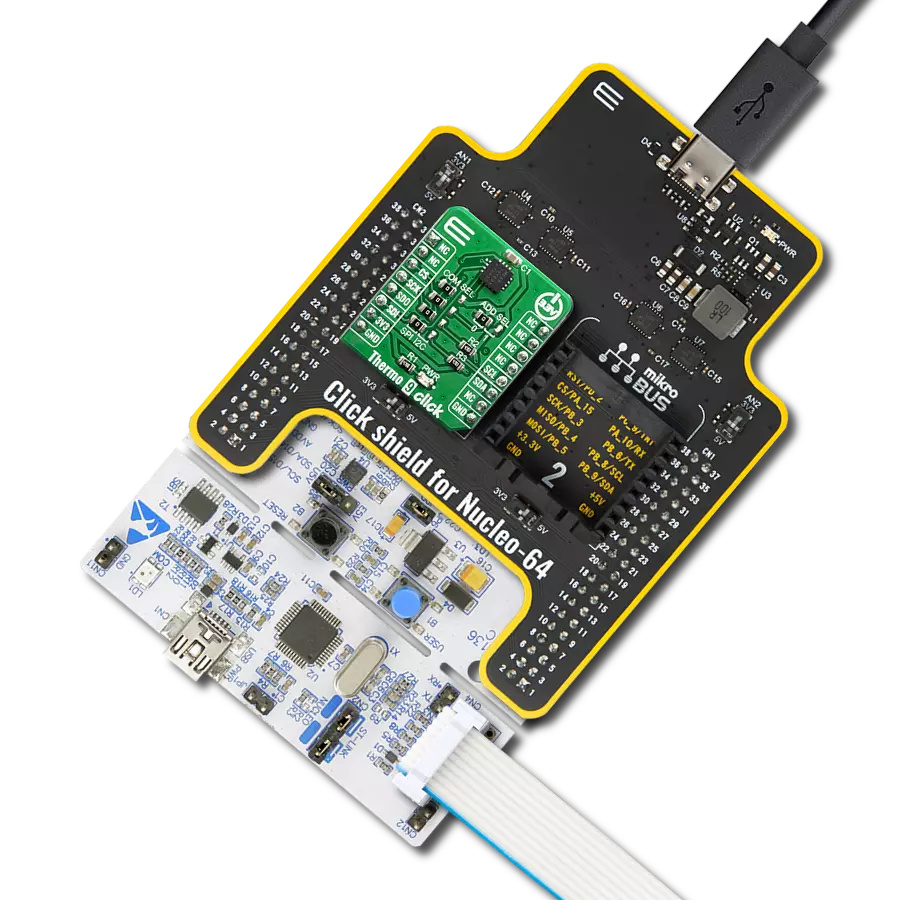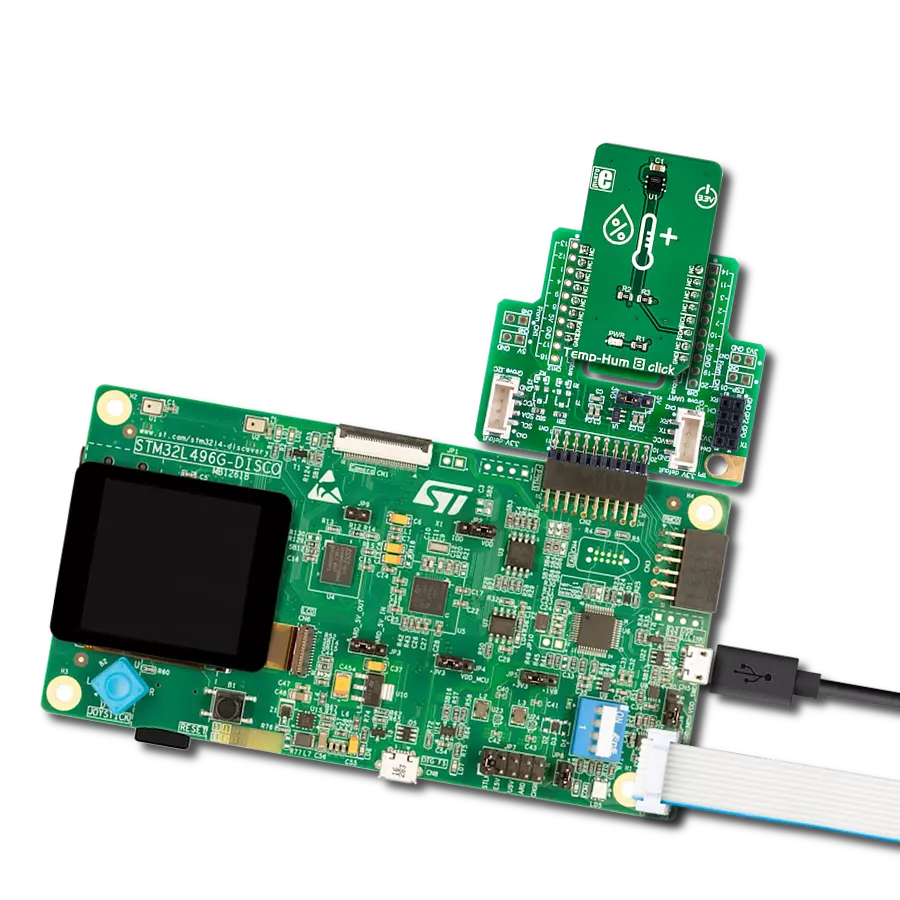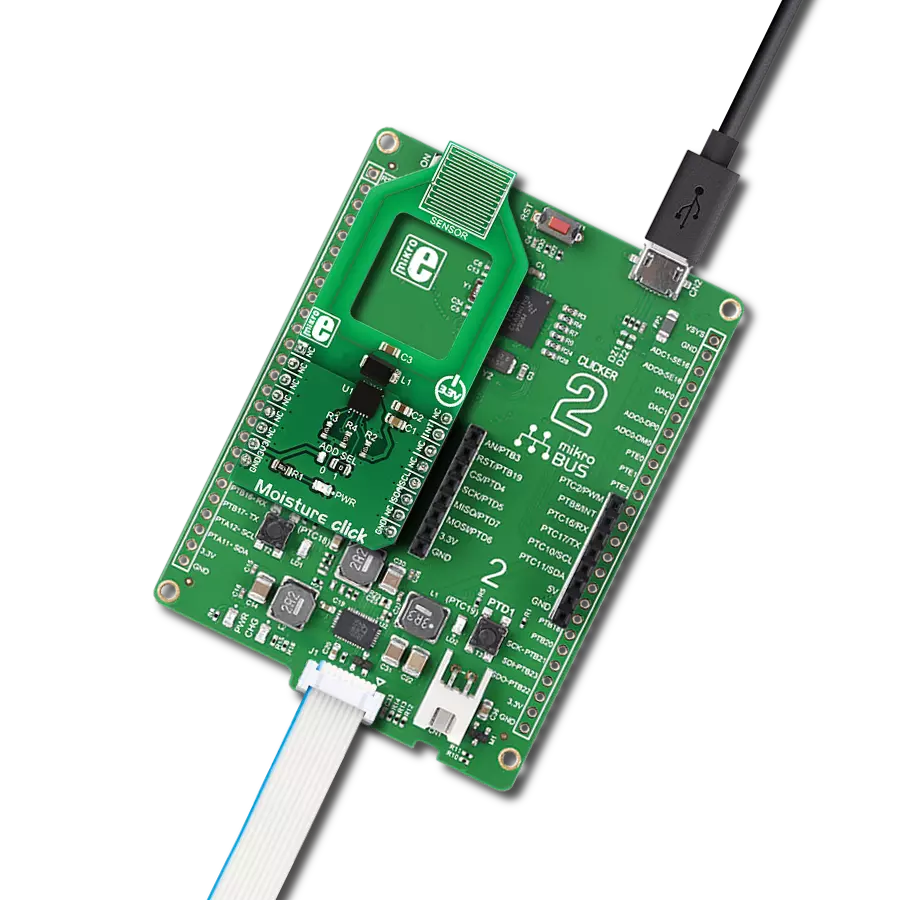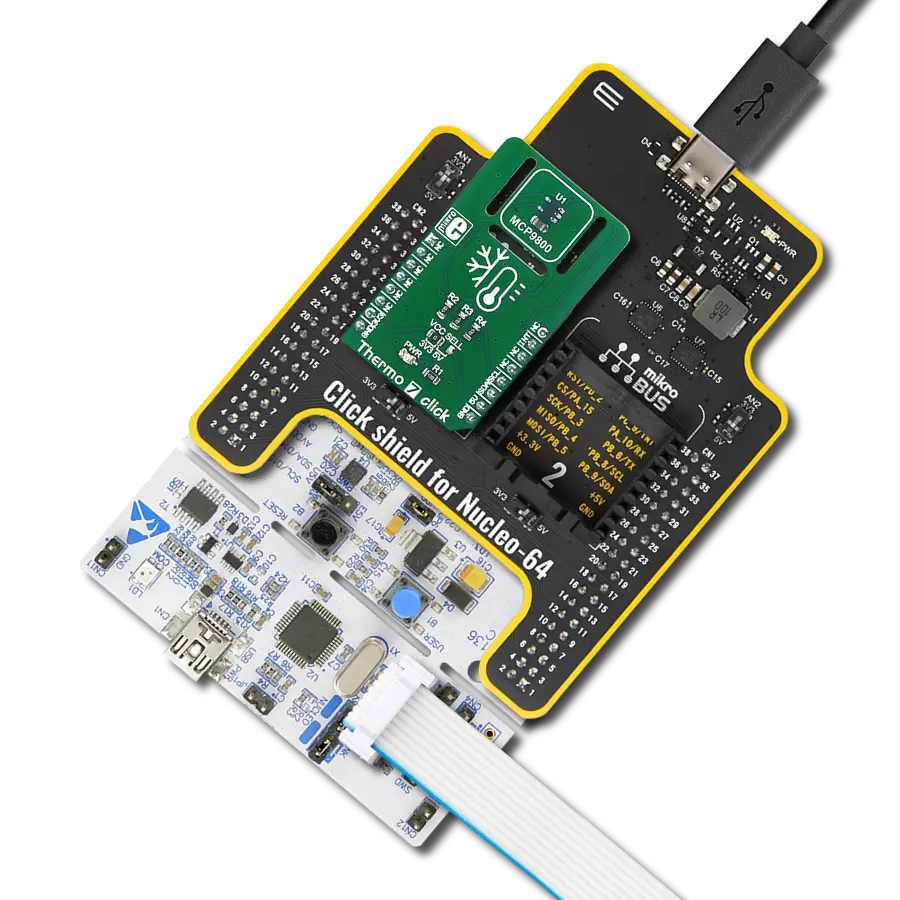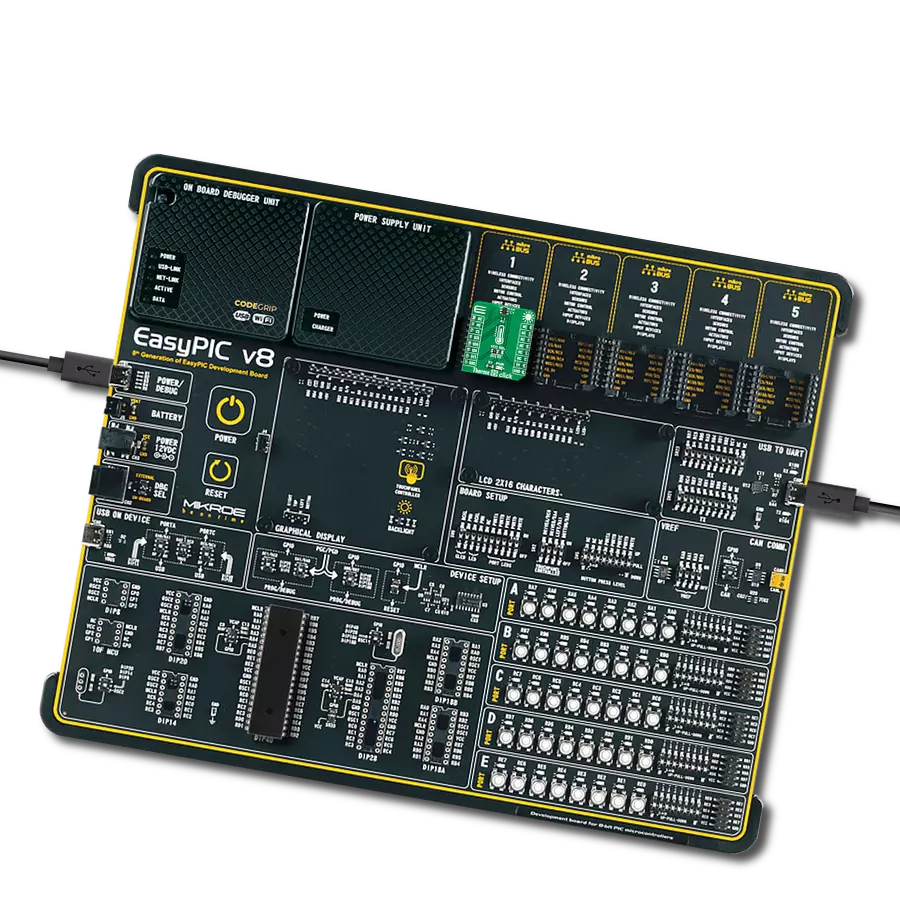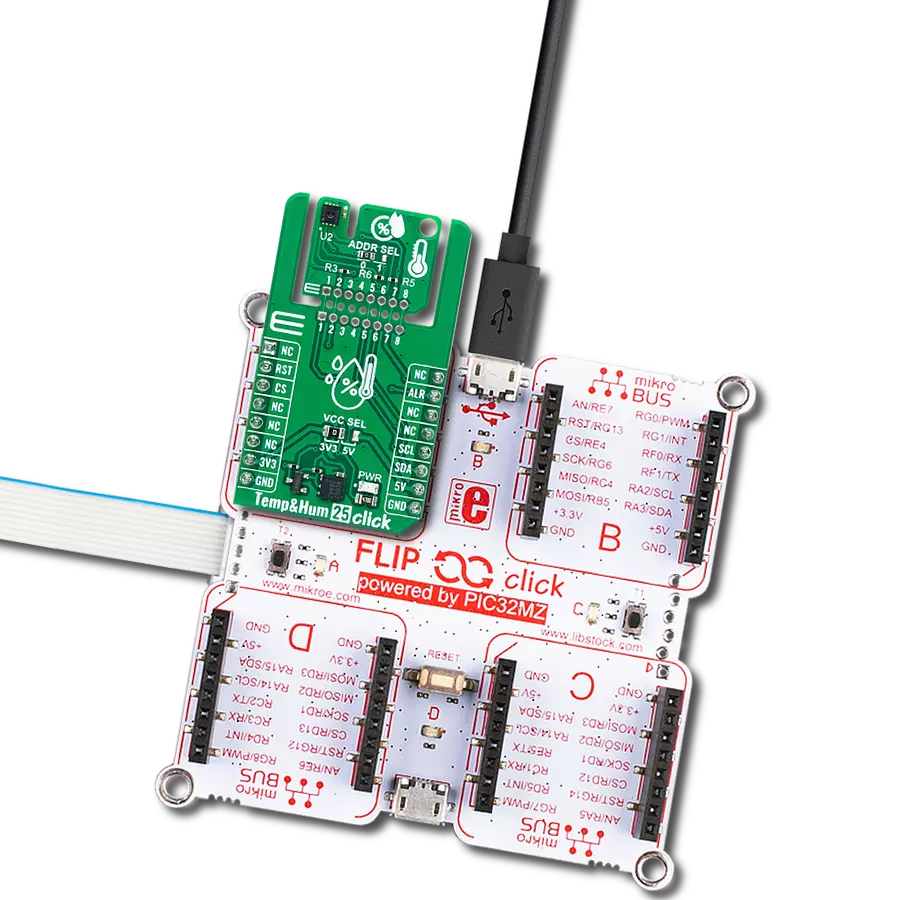Experience effortless comfort with our solution that maintains the perfect temperature and humidity levels
A
A
Hardware Overview
How does it work?
Temp&Hum 3 Click is based on the HDC2010, a low-power humidity and temperature digital sensor from Texas Instruments. This sensor is factory calibrated to 2% relative humidity and 0.2°C temperature accuracy. It has an integrated heating element that is used to evaporate condensation, protecting the sensor that way. This heating element can be simply activated by setting a bit in the appropriate register. In the case when the heater is powered on, the power consumption might rise to about 130mA. Internally, two sensors are connected to the ADC section, which can be set to sample measurements with the resolution of 9, 11 or 14 bits, based on the measurement time. The OTP memory holds the calibration coefficients that are applied to the measured value and the results are stored on the output registers, in the MSB/LSB format. These values are then used in formulas found in the HDC2010 datasheet so that the final temperature or relative humidity data can be
calculated. It is also possible to correct the offsets with custom values. HDC2010 IC uses the I2C protocol to communicate with the host MCU. Its I2C bus pins are routed to the mikroBUS™ I2C pins and are pulled to a HIGH logic level by the onboard resistors. The ADDR pin of the HDC2010 is routed to the CS pin of the mikroBUS™ and it represents the least significant bit of the I2C address. The final I2C address of this IC is determined by setting this pin either to a HIGH logic level for 1, or a LOW logic level for 0. Temp&Hum 3 click supports programmable interrupt engine, saving the host MCU from having to constantly poll the IC for data. An interrupt signal with a selectable polarity and behavior can be generated on the DRDY/INT pin of the HDC2010. It can be triggered by several event sources: it can be triggered by the temperature Lo/Hi threshold events, Humidity Lo/Hi events, as well as the readiness status of the measurement data. Setting up the interrupts can be
achieved by programming the appropriate IC registers via the I2C bus. More information about these registers can be found in the HDC2010 datasheet. HDC2010 IC itself is a very low power consuming device and it can work in two modes: sleep and active (measurement) mode. The device enters the sleep the mode as soon possible, to save power. While in the active mode, measurement can be either automatic with predefined output data rate (ODR) or on-demand. In the automatic mode, the measurement is triggered in predefined time segments, while on-demand measurement happens whenever the I2C command is sent. As soon as the single measurement is finished, the device falls back to a sleep mode. Onboard SMD jumper is used to select the power supply voltage. This allows Temp&Hum 3 click to be used with both 3.3V and 5V MCUs.
Features overview
Development board
Nucleo-64 with STM32F410RB MCU offers a cost-effective and adaptable platform for developers to explore new ideas and prototype their designs. This board harnesses the versatility of the STM32 microcontroller, enabling users to select the optimal balance of performance and power consumption for their projects. It accommodates the STM32 microcontroller in the LQFP64 package and includes essential components such as a user LED, which doubles as an ARDUINO® signal, alongside user and reset push-buttons, and a 32.768kHz crystal oscillator for precise timing operations. Designed with expansion and flexibility in mind, the Nucleo-64 board features an ARDUINO® Uno V3 expansion connector and ST morpho extension pin
headers, granting complete access to the STM32's I/Os for comprehensive project integration. Power supply options are adaptable, supporting ST-LINK USB VBUS or external power sources, ensuring adaptability in various development environments. The board also has an on-board ST-LINK debugger/programmer with USB re-enumeration capability, simplifying the programming and debugging process. Moreover, the board is designed to simplify advanced development with its external SMPS for efficient Vcore logic supply, support for USB Device full speed or USB SNK/UFP full speed, and built-in cryptographic features, enhancing both the power efficiency and security of projects. Additional connectivity is
provided through dedicated connectors for external SMPS experimentation, a USB connector for the ST-LINK, and a MIPI® debug connector, expanding the possibilities for hardware interfacing and experimentation. Developers will find extensive support through comprehensive free software libraries and examples, courtesy of the STM32Cube MCU Package. This, combined with compatibility with a wide array of Integrated Development Environments (IDEs), including IAR Embedded Workbench®, MDK-ARM, and STM32CubeIDE, ensures a smooth and efficient development experience, allowing users to fully leverage the capabilities of the Nucleo-64 board in their projects.
Microcontroller Overview
MCU Card / MCU

Architecture
ARM Cortex-M4
MCU Memory (KB)
128
Silicon Vendor
STMicroelectronics
Pin count
64
RAM (Bytes)
32768
You complete me!
Accessories
Click Shield for Nucleo-64 comes equipped with two proprietary mikroBUS™ sockets, allowing all the Click board™ devices to be interfaced with the STM32 Nucleo-64 board with no effort. This way, Mikroe allows its users to add any functionality from our ever-growing range of Click boards™, such as WiFi, GSM, GPS, Bluetooth, ZigBee, environmental sensors, LEDs, speech recognition, motor control, movement sensors, and many more. More than 1537 Click boards™, which can be stacked and integrated, are at your disposal. The STM32 Nucleo-64 boards are based on the microcontrollers in 64-pin packages, a 32-bit MCU with an ARM Cortex M4 processor operating at 84MHz, 512Kb Flash, and 96KB SRAM, divided into two regions where the top section represents the ST-Link/V2 debugger and programmer while the bottom section of the board is an actual development board. These boards are controlled and powered conveniently through a USB connection to program and efficiently debug the Nucleo-64 board out of the box, with an additional USB cable connected to the USB mini port on the board. Most of the STM32 microcontroller pins are brought to the IO pins on the left and right edge of the board, which are then connected to two existing mikroBUS™ sockets. This Click Shield also has several switches that perform functions such as selecting the logic levels of analog signals on mikroBUS™ sockets and selecting logic voltage levels of the mikroBUS™ sockets themselves. Besides, the user is offered the possibility of using any Click board™ with the help of existing bidirectional level-shifting voltage translators, regardless of whether the Click board™ operates at a 3.3V or 5V logic voltage level. Once you connect the STM32 Nucleo-64 board with our Click Shield for Nucleo-64, you can access hundreds of Click boards™, working with 3.3V or 5V logic voltage levels.
Used MCU Pins
mikroBUS™ mapper
Take a closer look
Click board™ Schematic

Step by step
Project assembly
Software Support
Library Description
This library contains API for Temp&Hum 3 Click driver.
Key functions:
temphum3_get_temperature- Get temperature valuetemphum3_get_huminidy- Get temperature valuetemphum3_get_max_hum- Get maximum temperature value
Open Source
Code example
The complete application code and a ready-to-use project are available through the NECTO Studio Package Manager for direct installation in the NECTO Studio. The application code can also be found on the MIKROE GitHub account.
/*!
* \file
* \brief TempHum 3 Click example
*
* # Description
* This application reads temperature and humidity data.
*
* The demo application is composed of two sections :
*
* ## Application Init
* Initializes the driver and performs the Click default configuration.
*
* ## Application Task
* Reads the temperature and huminidy and logs results to the USB UART every 500 ms.
*
* \author Petar Suknjaja
*
*/
#include "board.h"
#include "log.h"
#include "temphum3.h"
static temphum3_t temphum3;
static log_t logger;
void application_init ( void )
{
log_cfg_t log_cfg;
temphum3_cfg_t temphum3_cfg;
/**
* Logger initialization.
* Default baud rate: 115200
* Default log level: LOG_LEVEL_DEBUG
* @note If USB_UART_RX and USB_UART_TX
* are defined as HAL_PIN_NC, you will
* need to define them manually for log to work.
* See @b LOG_MAP_USB_UART macro definition for detailed explanation.
*/
LOG_MAP_USB_UART( log_cfg );
log_init( &logger, &log_cfg );
log_info( &logger, " Application Init " );
// Click initialization.
temphum3_cfg_setup( &temphum3_cfg );
TEMPHUM3_MAP_MIKROBUS( temphum3_cfg, MIKROBUS_1 );
if ( I2C_MASTER_ERROR == temphum3_init( &temphum3, &temphum3_cfg ) )
{
log_error( &logger, " Communication init." );
for ( ; ; );
}
temphum3_default_cfg( &temphum3 );
log_info( &logger, " Application Task " );
}
void application_task ( void )
{
float temperature = 0;
float humidity = 0;
temperature = temphum3_get_temperature( &temphum3 );
log_printf( &logger, " Temperature : %.2f C \r\n", temperature );
humidity = temphum3_get_humidity( &temphum3 );
log_printf( &logger, " Humidity : %.1f %% \r\n", humidity );
Delay_ms ( 500 );
}
int main ( void )
{
/* Do not remove this line or clock might not be set correctly. */
#ifdef PREINIT_SUPPORTED
preinit();
#endif
application_init( );
for ( ; ; )
{
application_task( );
}
return 0;
}
// ------------------------------------------------------------------------ END
Additional Support
Resources
Category:Temperature & humidity



















